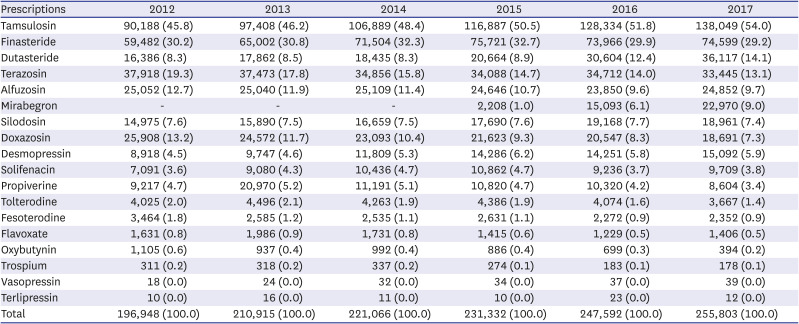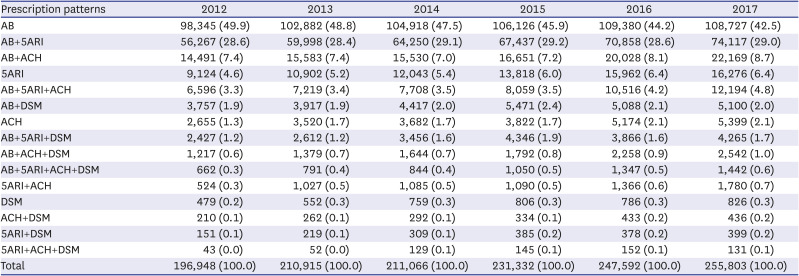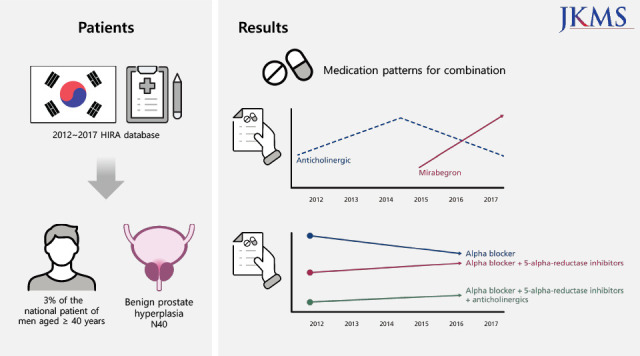1. Roehrborn CG. Benign prostatic hyperplasia: an overview. Rev Urol. 2005; 7(Suppl 9):S3–14.
2. Jo JK, Shinn SH, Kim KS, Moon HS. Changes in prevalence and treatment pattern of benign prostatic hyperplasia in Korea. Int Neurourol J. 2021; 25(4):347–354. PMID:
33504124.
3. Lerner LB, McVary KT, Barry MJ, Bixler BR, Dahm P, Das AK, et al. Management of lower urinary tract symptoms attributed to benign prostatic hyperplasia: AUA GUIDELINE PART I-Initial Work-up and Medical Management. J Urol. 2021; 206(4):806–817. PMID:
34384237.
4. Lee YJ, Lee JW, Park J, Seo SI, Chung JI, Yoo TK, et al. Nationwide incidence and treatment pattern of benign prostatic hyperplasia in Korea. Investig Clin Urol. 2016; 57(6):424–430.
5. Hakimi Z, Johnson M, Nazir J, Blak B, Odeyemi IA. Drug treatment patterns for the management of men with lower urinary tract symptoms associated with benign prostatic hyperplasia who have both storage and voiding symptoms: a study using the health improvement network UK primary care data. Curr Med Res Opin. 2015; 31(1):43–50. PMID:
25333647.
6. Kang JY, Min GE, Son H, Kim HT, Lee HL. National-wide data on the treatment of BPH in Korea. Prostate Cancer Prostatic Dis. 2011; 14(3):243–247. PMID:
21502967.
7. Oh CY, Lee SH, Yoo SJ, Chung BH. Korean urologist’s view of practice patterns in diagnosis and management of benign prostatic hyperplasia: a nationwide survey. Yonsei Med J. 2010; 51(2):248–252. PMID:
20191018.
8. Kim L, Sakong J, Kim Y, Kim S, Kim S, Tchoe B, et al. Developing the inpatient sample for the national health insurance claims data. Health Policy Manag. 2013; 23(2):152–161.
9. Launer BM, McVary KT, Ricke WA, Lloyd GL. The rising worldwide impact of benign prostatic hyperplasia. BJU Int. 2021; 127(6):722–728. PMID:
33124118.
10. Welliver C, Feinstein L, Ward JB, Fwu CW, Kirkali Z, Bavendam T, et al. Trends in lower urinary tract symptoms associated with benign prostatic hyperplasia, 2004 to 2013: the Urologic Diseases in America Project. J Urol. 2020; 203(1):171–178. PMID:
31430232.
11. Irwin DE, Milsom I, Hunskaar S, Reilly K, Kopp Z, Herschorn S, et al. Population-based survey of urinary incontinence, overactive bladder, and other lower urinary tract symptoms in five countries: results of the EPIC study. Eur Urol. 2006; 50(6):1306–1314. PMID:
17049716.
12. Parsons JK, Bergstrom J, Silberstein J, Barrett-Connor E. Prevalence and characteristics of lower urinary tract symptoms in men aged > or = 80 years. Urology. 2008; 72(2):318–321. PMID:
18554695.
13. Kava BR, Verbeek AE, Wruck JM, Gittelman M. Tamsulosin dispensation patterns in the United States: a real-world, longitudinal, population claims database analysis. Transl Androl Urol. 2019; 8(4):329–338. PMID:
31555556.
14. Lee JY, Kim HW, Lee SJ, Koh JS, Suh HJ, Chancellor MB. Comparison of doxazosin with or without tolterodine in men with symptomatic bladder outlet obstruction and an overactive bladder. BJU Int. 2004; 94(6):817–820. PMID:
15476515.
15. Song Y, Chen G, Huang P, Hu C, Liu X. Effects of tamsulosin combined with solifenacin on lower urinary tract symptoms: evidence from a systematic review, meta-analysis, and trial sequential analysis of randomized controlled trials. Front Pharmacol. 2020; 11:763. PMID:
32528291.
16. Chapple C, Herschorn S, Abrams P, Sun F, Brodsky M, Guan Z. Tolterodine treatment improves storage symptoms suggestive of overactive bladder in men treated with alpha-blockers. Eur Urol. 2009; 56(3):534–541. PMID:
19070418.
17. Kaplan SA, McCammon K, Fincher R, Fakhoury A, He W. Safety and tolerability of solifenacin add-on therapy to alpha-blocker treated men with residual urgency and frequency. J Urol. 2009; 182(6):2825–2830. PMID:
19837435.
18. Kaplan SA, Roehrborn CG, Rovner ES, Carlsson M, Bavendam T, Guan Z. Tolterodine and tamsulosin for treatment of men with lower urinary tract symptoms and overactive bladder: a randomized controlled trial. JAMA. 2006; 296(19):2319–2328. PMID:
17105794.
19. Lee KS, Choo MS, Kim DY, Kim JC, Kim HJ, Min KS, et al. Combination treatment with propiverine hydrochloride plus doxazosin controlled release gastrointestinal therapeutic system formulation for overactive bladder and coexisting benign prostatic obstruction: a prospective, randomized, controlled multicenter study. J Urol. 2005; 174(4 Pt 1):1334–1338. PMID:
16145414.
20. Matsuo T, Miyata Y, Kakoki K, Yuzuriha M, Asai A, Ohba K, et al. The efficacy of mirabegron additional therapy for lower urinary tract symptoms after treatment with α1-adrenergic receptor blocker monotherapy: prospective analysis of elderly men. BMC Urol. 2016; 16(1):45. PMID:
27473059.
21. Ichihara K, Masumori N, Fukuta F, Tsukamoto T, Iwasawa A, Tanaka Y. A randomized controlled study of the efficacy of tamsulosin monotherapy and its combination with mirabegron for overactive bladder induced by benign prostatic obstruction. J Urol. 2015; 193(3):921–926. PMID:
25254938.
22. Gratzke C, van Maanen R, Chapple C, Abrams P, Herschorn S, Robinson D, et al. Long-term safety and efficacy of mirabegron and solifenacin in combination compared with monotherapy in patients with overactive bladder: a randomized, multicenter phase 3 study (SYNERGY II). Eur Urol. 2018; 74(4):501–509. PMID:
29866467.







 PDF
PDF Citation
Citation Print
Print




 XML Download
XML Download